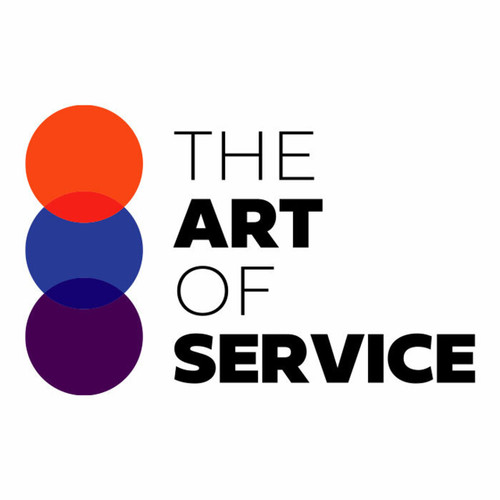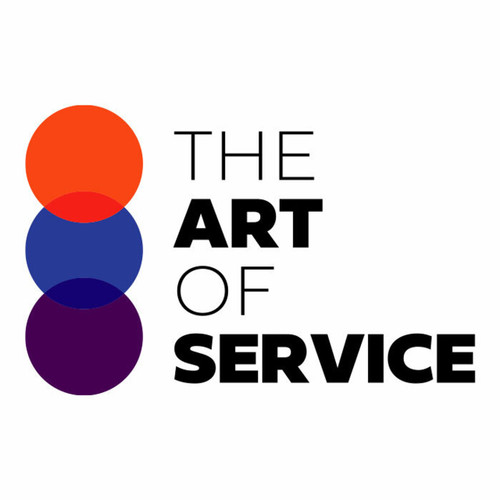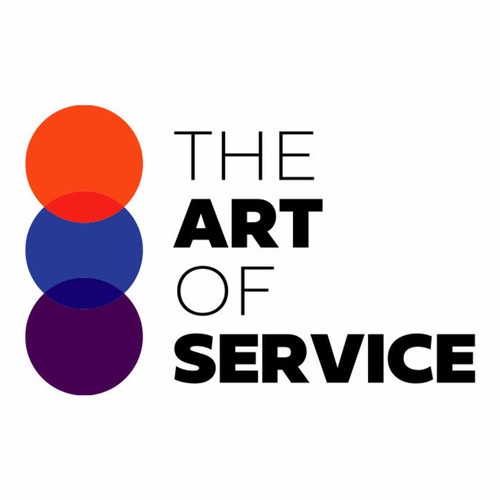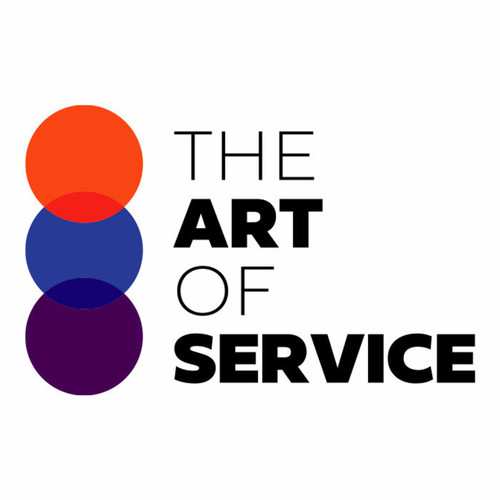Our Role Based Access and Attack Surface Reduction Knowledge Base is the ultimate tool for professionals and businesses looking to prioritize their security efforts and achieve quick and impactful results.
Our dataset contains 1567 carefully selected Role Based Access and Attack Surface Reduction requirements, solutions, benefits, results, and real-world case studies/use cases.
With the most important questions to ask, organized by urgency and scope, you can efficiently address any security issues your company may face.
Compared to competitors and alternative products, our Role Based Access and Attack Surface Reduction dataset stands out as the most comprehensive and user-friendly option.
With a focus on professionals, our product provides an in-depth overview of RBAC and attack surface reduction techniques, making it a must-have for any business serious about security.
But what sets us apart even more is our emphasis on affordability and ease-of-use.
Our DIY approach makes it accessible to all, without compromising on quality or effectiveness.
You no longer have to break the bank to adequately protect your organization′s assets.
Not only does our dataset provide detailed specifications and descriptions of our product, but it also offers valuable insights into the benefits of implementing RBAC and attack surface reduction strategies.
Backed by extensive research, our knowledge base has proven to be a game-changer for countless companies, helping them save time and resources while achieving a more secure and efficient system.
Don′t let the cost hold you back either.
Our Role Based Access and Attack Surface Reduction Knowledge Base is a cost-effective solution, saving you money in the long run by preventing potential cyber attacks and data breaches.
And with our clear pros and cons breakdown, you can make an informed decision that best suits your business′s needs.
In a world where cyber threats are constantly evolving, it′s crucial to have the right tools in place to protect your valuable assets.
Our Role Based Access and Attack Surface Reduction Knowledge Base does just that, providing you with the necessary guidance and resources to safeguard your organization′s data and systems.
Don′t wait any longer, secure your business today!
Discover Insights, Make Informed Decisions, and Stay Ahead of the Curve:
Key Features:
Comprehensive set of 1567 prioritized Role Based Access requirements. - Extensive coverage of 187 Role Based Access topic scopes.
- In-depth analysis of 187 Role Based Access step-by-step solutions, benefits, BHAGs.
- Detailed examination of 187 Role Based Access case studies and use cases.
- Digital download upon purchase.
- Enjoy lifetime document updates included with your purchase.
- Benefit from a fully editable and customizable Excel format.
- Trusted and utilized by over 10,000 organizations.
- Covering: Wireless Security Network Encryption, System Lockdown, Phishing Protection, System Activity Logs, Incident Response Coverage, Business Continuity, Incident Response Planning, Testing Process, Coverage Analysis, Account Lockout, Compliance Assessment, Intrusion Detection System, Patch Management Patch Prioritization, Media Disposal, Unsanctioned Devices, Cloud Services, Communication Protocols, Single Sign On, Test Documentation, Code Analysis, Mobile Device Management Security Policies, Asset Management Inventory Tracking, Cloud Access Security Broker Cloud Application Control, Network Access Control Network Authentication, Restore Point, Patch Management, Flat Network, User Behavior Analysis, Contractual Obligations, Security Audit Auditing Tools, Security Auditing Policy Compliance, Demilitarized Zone, Access Requests, Extraction Controls, Log Analysis, Least Privilege Access, Access Controls, Behavioral Analysis, Disaster Recovery Plan Disaster Response, Anomaly Detection, Backup Scheduling, Password Policies Password Complexity, Off Site Storage, Device Hardening System Hardening, Browser Security, Honeypot Deployment, Threat Modeling, User Consent, Mobile Security Device Management, Data Anonymization, Session Recording, Audits And Assessments, Audit Logs, Regulatory Compliance Reporting, Access Revocation, User Provisioning, Mobile Device Encryption, Endpoint Protection Malware Prevention, Vulnerability Management Risk Assessment, Vulnerability Scanning, Secure Channels, Risk Assessment Framework, Forensics Investigation, Self Service Password Reset, Security Incident Response Incident Handling, Change Default Credentials, Data Expiration Policies, Change Approval Policies, Data At Rest Encryption, Firewall Configuration, Intrusion Detection, Emergency Patches, Attack Surface, Database Security Data Encryption, Privacy Impact Assessment, Security Awareness Phishing Simulation, Privileged Access Management, Production Deployment, Plan Testing, Malware Protection Antivirus, Secure Protocols, Privacy Data Protection Regulation, Identity Management Authentication Processes, Incident Response Response Plan, Network Monitoring Traffic Analysis, Documentation Updates, Network Segmentation Policies, Web Filtering Content Filtering, Attack Surface Reduction, Asset Value Classification, Biometric Authentication, Secure Development Security Training, Disaster Recovery Readiness, Risk Evaluation, Forgot Password Process, VM Isolation, Disposal Procedures, Compliance Regulatory Standards, Data Classification Data Labeling, Password Management Password Storage, Privacy By Design, Rollback Procedure, Cybersecurity Training, Recovery Procedures, Integrity Baseline, Third Party Security Vendor Risk Assessment, Business Continuity Recovery Objectives, Screen Sharing, Data Encryption, Anti Malware, Rogue Access Point Detection, Access Management Identity Verification, Information Protection Tips, Application Security Code Reviews, Host Intrusion Prevention, Disaster Recovery Plan, Attack Mitigation, Real Time Threat Detection, Security Controls Review, Threat Intelligence Threat Feeds, Cyber Insurance Risk Assessment, Cloud Security Data Encryption, Virtualization Security Hypervisor Security, Web Application Firewall, Backup And Recovery Disaster Recovery, Social Engineering, Security Analytics Data Visualization, Network Segmentation Rules, Endpoint Detection And Response, Web Access Control, Password Expiration, Shadow IT Discovery, Role Based Access, Remote Desktop Control, Change Management Change Approval Process, Security Requirements, Audit Trail Review, Change Tracking System, Risk Management Risk Mitigation Strategies, Packet Filtering, System Logs, Data Privacy Data Protection Policies, Data Exfiltration, Backup Frequency, Data Backup Data Retention, Multi Factor Authentication, Data Sensitivity Assessment, Network Segmentation Micro Segmentation, Physical Security Video Surveillance, Segmentation Policies, Policy Enforcement, Impact Analysis, User Awareness Security Training, Shadow IT Control, Dark Web Monitoring, Firewall Rules Rule Review, Data Loss Prevention, Disaster Recovery Backup Solutions, Real Time Alerts, Encryption Encryption Key Management, Behavioral Analytics, Access Controls Least Privilege, Vulnerability Testing, Cloud Backup Cloud Storage, Monitoring Tools, Patch Deployment, Secure Storage, Password Policies, Real Time Protection, Complexity Reduction, Application Control, System Recovery, Input Validation, Access Point Security, App Permissions, Deny By Default, Vulnerability Detection, Change Control Change Management Process, Continuous Risk Monitoring, Endpoint Compliance, Crisis Communication, Role Based Authorization, Incremental Backups, Risk Assessment Threat Analysis, Remote Wipe, Penetration Testing, Automated Updates
Role Based Access Assessment Dataset - Utilization, Solutions, Advantages, BHAG (Big Hairy Audacious Goal):
Role Based Access
The organization should securely delete or anonymize the data used for testing to ensure proper role-based access is maintained after the upgrade.
1. Implement Role-Based Access Control (RBAC) to restrict access to sensitive data.
- RBAC limits access to data based on assigned user roles, minimizing the risk of exposure.
2. Utilize data sanitization techniques to remove sensitive information after testing.
- Data sanitization ensures that confidential data is removed before the upgrade is completed.
3. Encrypt all data used for testing to protect it from unauthorized access.
- Encryption adds an additional layer of security, making it more difficult for hackers to access sensitive data.
4. Implement a robust data governance policy to regulate the use and handling of data.
- A well-defined data governance policy establishes clear rules and procedures for managing data, reducing the likelihood of data breaches.
5. Utilize secure development frameworks (such as OWASP) to identify and mitigate potential vulnerabilities.
- Secure development frameworks provide guidelines for creating secure software, reducing the risk of access to sensitive data by malicious actors.
6. Regularly review access privileges and revoke any unnecessary access.
- By regularly reviewing and revoking access, organizations can ensure that only authorized individuals have access to sensitive data.
7. Train employees on data handling and security best practices.
- Educating employees on data handling and security can minimize the risk of human error or intentional misuse of sensitive data.
CONTROL QUESTION: What should the organization do with the data used for testing when it completes the upgrade?
Big Hairy Audacious Goal (BHAG) for 10 years from now:
The organization should strive to achieve a fully automated and seamless Role Based Access system, where all user access is based on their specific role and responsibilities within the organization. This system should be highly secure and efficient, with real-time updates and customized levels of access for every individual employee.
In addition, the organization should aim to implement advanced data encryption and protection measures to safeguard sensitive data used for testing and access control. All data should be regularly audited and monitored to ensure compliance with industry regulations and best practices.
Furthermore, the organization should leverage artificial intelligence and machine learning technologies to continuously improve and optimize the Role Based Access system, making it adaptable to changing needs and evolving threats.
Ultimately, the goal for Role Based Access in 10 years should be to foster a culture of trust, transparency, and accountability within the organization, while also providing a seamless and secure user experience for employees. This will not only enhance overall organizational efficiency and productivity but also demonstrate the organization′s commitment to data privacy and security.
Customer Testimonials:
"This dataset has been invaluable in developing accurate and profitable investment recommendations for my clients. It`s a powerful tool for any financial professional."
"I can`t recommend this dataset enough. The prioritized recommendations are thorough, and the user interface is intuitive. It has become an indispensable tool in my decision-making process."
"It`s rare to find a product that exceeds expectations so dramatically. This dataset is truly a masterpiece."
Role Based Access Case Study/Use Case example - How to use:
Client Situation:
XYZ Inc. is a large multinational organization with operations in various countries. The organization is currently using an outdated legacy system for managing user access to its systems and data. This has led to issues such as data breaches, unauthorized access to sensitive information, and difficulty in complying with regulatory requirements. To address these challenges and improve overall security, the organization has decided to upgrade to a Role Based Access Control (RBAC) system. The RBAC system will provide a granular level of access control based on job roles and responsibilities, ensuring that only authorized users have access to specific data and resources.
Consulting Methodology:
Our consulting firm, ABC Consultants, was engaged by XYZ Inc. to assist in the implementation of the RBAC system. Our approach to this project was divided into four phases:
1. Assessment and planning: In the first phase, we conducted a thorough assessment of the organization′s current access control processes and systems. We also worked closely with the client to understand their business needs and objectives, as well as any regulatory requirements that needed to be met. Based on our findings, we developed a comprehensive implementation plan for the RBAC system.
2. Design and development: In this phase, we worked with the organization′s IT team to design and develop the RBAC system based on the implementation plan. This involved configuring user roles, permissions, and access controls, as well as integrating the system with existing applications and databases.
3. Testing and training: Once the system was developed, we conducted rigorous testing to ensure its effectiveness and compatibility with the organization′s IT infrastructure. We also provided training to the organization′s employees on how to use the RBAC system effectively.
4. Deployment and post-implementation support: The final phase involved deploying the RBAC system in the organization′s production environment and providing post-implementation support to ensure a smooth transition and address any issues that may arise.
Deliverables:
1. Assessment report: This document provided a detailed analysis of the organization′s current access control processes and an overview of the RBAC system′s features and benefits.
2. Implementation plan: This document outlined the specific steps and timelines for implementing the RBAC system, as well as the roles and responsibilities of each team member.
3. RBAC system design: This included the design document, implementation guides, and other technical documents related to the development of the RBAC system.
4. Testing report: This document provided a summary of the testing process and results, highlighting any issues or concerns that were identified and resolved.
5. Training materials: We provided the organization′s employees with training materials, including user manuals and video tutorials, to familiarize them with the RBAC system.
6. Post-implementation support: We provided ongoing support to the organization to ensure the RBAC system′s smooth functioning and addressed any user feedback or technical issues that arose.
Implementation Challenges:
The implementation of the RBAC system posed several challenges, including:
1. Resistance to change: Any change in technology and processes can be met with resistance, especially in large organizations. Our consulting team had to work closely with the organization′s employees and address their concerns about the new system.
2. Complexity of existing systems: Integrating the RBAC system with the organization′s existing applications and databases proved to be a complex task, requiring close collaboration between our consulting team and the organization′s IT department.
3. Compliance with regulatory requirements: As XYZ Inc. operates in multiple countries, compliance with various regulatory requirements was a crucial aspect that needed to be considered during the implementation process.
KPIs:
To measure the success of the RBAC system implementation, we set the following key performance indicators (KPIs):
1. Reduction in data breaches: A significant measure of the RBAC system′s effectiveness was the reduction in data breaches or unauthorized access to sensitive information.
2. User satisfaction: We measured user satisfaction by conducting surveys and gathering feedback from the organization′s employees regarding the ease of use and effectiveness of the RBAC system.
3. Compliance with regulatory requirements: The RBAC system had to meet various regulatory guidelines, and we measured its compliance with these requirements through audits and reviews.
Management Considerations:
1. Change management: As with any new system implementation, change management was critical to the success of this project. Our consulting team worked closely with the organization′s management to address employee concerns and ensure a smooth transition to the new system.
2. Cost-benefit analysis: Our team conducted a cost-benefit analysis to determine the impact of the RBAC system on the organization′s bottom line. This analysis helped the organization make informed decisions about the implementation.
3. Ongoing maintenance and support: The RBAC system required ongoing maintenance and support to ensure its smooth functioning and address any issues that may arise. We provided the organization with a plan for post-implementation support and maintenance.
Conclusion:
The successful implementation of the RBAC system has significantly improved XYZ Inc.′s access control processes, reducing the risk of data breaches and unauthorized access. The organization can now easily comply with regulatory requirements and enhance overall security. The RBAC system′s user-friendly interface and granular access control have also increased user satisfaction. As a result, the organization has seen a significant return on investment in terms of improved security and reduced risks.
Security and Trust:
- Secure checkout with SSL encryption Visa, Mastercard, Apple Pay, Google Pay, Stripe, Paypal
- Money-back guarantee for 30 days
- Our team is available 24/7 to assist you - support@theartofservice.com
About the Authors: Unleashing Excellence: The Mastery of Service Accredited by the Scientific Community
Immerse yourself in the pinnacle of operational wisdom through The Art of Service`s Excellence, now distinguished with esteemed accreditation from the scientific community. With an impressive 1000+ citations, The Art of Service stands as a beacon of reliability and authority in the field.Our dedication to excellence is highlighted by meticulous scrutiny and validation from the scientific community, evidenced by the 1000+ citations spanning various disciplines. Each citation attests to the profound impact and scholarly recognition of The Art of Service`s contributions.
Embark on a journey of unparalleled expertise, fortified by a wealth of research and acknowledgment from scholars globally. Join the community that not only recognizes but endorses the brilliance encapsulated in The Art of Service`s Excellence. Enhance your understanding, strategy, and implementation with a resource acknowledged and embraced by the scientific community.
Embrace excellence. Embrace The Art of Service.
Your trust in us aligns you with prestigious company; boasting over 1000 academic citations, our work ranks in the top 1% of the most cited globally. Explore our scholarly contributions at: https://scholar.google.com/scholar?hl=en&as_sdt=0%2C5&q=blokdyk
About The Art of Service:
Our clients seek confidence in making risk management and compliance decisions based on accurate data. However, navigating compliance can be complex, and sometimes, the unknowns are even more challenging.
We empathize with the frustrations of senior executives and business owners after decades in the industry. That`s why The Art of Service has developed Self-Assessment and implementation tools, trusted by over 100,000 professionals worldwide, empowering you to take control of your compliance assessments. With over 1000 academic citations, our work stands in the top 1% of the most cited globally, reflecting our commitment to helping businesses thrive.
Founders:
Gerard Blokdyk
LinkedIn: https://www.linkedin.com/in/gerardblokdijk/
Ivanka Menken
LinkedIn: https://www.linkedin.com/in/ivankamenken/











